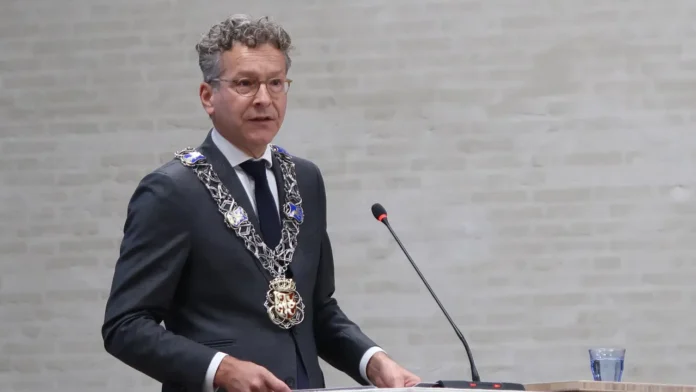Jeroen Dijsselbloem was sworn in as mayor of Eindhoven about thirteen months ago. He discusses the city’s challenges in detail with Studio040. The housing construction challenge is discussed in the first part of the interview. “We must do everything we can to keep construction going.”
“We want to build 40,000 more homes in the coming years. If interest rates rise, inflation rises and construction costs skyrocket, things will become increasingly difficult. We must do everything we can to keep that construction going,” says Dijsselbloem.
The mayor does not think that Eindhoven is aiming too high when it comes to housing construction. “Am I sure it will all work out? No, because developments in and around Eindhoven are going so fast – albeit nearly all positive – that the pressure on the housing market, the labour market and schools is becoming very great. We are not succeeding in shortening the waiting lists.
“Flattening the wave”
“What we are doing now to prevent construction projects from coming to a standstill due to circumstances is that we are trying to get rid of that wave pattern. In construction it is always like this: things either go extremely well or they collapse. So, we are talking as a municipality – what is needed to get a project off the ground. Should there be more houses? Does anything need to change in the composition of the type of home? Do we have to bear any costs? Do you need a guarantee?”
Taking over risks
Dijsselbloem also thinks he has a good partner with the business community in the region. “It helps us that the business community has said: we want to create a fund for housing construction, with which you can issue guarantees. Then you can say to a developer: you may not have sold or rented 70 per cent of your houses yet, but you should start building anyway. If a risk arises because it has not yet been sold or rented, we will take over that risk or those financial burdens.”
“That does not mean that you just give money to a project developer, perhaps that is not necessary. Maybe construction can proceed smoothly, and it will all end well. But those developers are insecure. So, we can look at ways to remove that uncertainty. If the business community helps by creating such a fund, then that is great.”
Self confidence
Dijsselbloem does not want to say how big that fund should be. “I’m not going to make any statements about that because it is an initiative of the business community. It’s about what they want to put into it – it’s also a question of what it takes. If things go well, a guaranteed scheme is hardly called upon. We have the self-confidence to say: ‘Things are going so well in Eindhoven, if you start building now, those homes will be sold or rented, because there is a huge need for homes in Eindhoven’.”
The municipality is still discussing whether it will ultimately be the municipality that will act as guarantor or the business community, Dijsselbloem said. “But the business community has said two things, namely: we are not going to build for our own people, and two: we do want to help the municipalities in this region to keep construction going. And that’s how we ended up with that fund.”
‘We also need each other tomorrow’
It is unfortunate that the municipality is now dependent on the same real estate developers in housing construction who built too little in the years when conditions were good. However, the mayor does not feel trapped by the developers. “The relationships are not like that. Most developers have been in Eindhoven for a long time and know that they want to do the next project in Eindhoven. So that collaboration is important because we need each other today but again tomorrow.”
Nevertheless, it became clear that around the development of the Stadhuisplein, developers are directly opposed to the municipality: While Eindhoven aims for 85 percent ‘affordable’ housing, research made it clear that real estate developers only want to build affordable housing at 15 percent. ‘Affordable’ refers to both social housing and medium-priced housing.
Push back or accommodate
“They can try that. But I don’t think Eindhoven politicians agree with that,” says Dijsselbloem. “But that happens all the time in construction. We know that from the past. If construction costs increase, project developers will say: ‘My calculations now looks less attractive. The municipality can do it a little less.”
“Municipalities will then push back or see how they can accommodate those project developers,” says Dijsselbloem. “I just gave you an example of how that can be done. But you must look at it per project, per developer. Things are just going wrong right now. But the municipality has more options than just saying: ‘well, let go of those social objectives. ‘”
Horror
According to the mayor, it is also clear what happens if a city abandons those objectives. “We know the example of Amsterdam within the ring road. Low and even middle incomes have been pushed away there. Eindhoven still has the opportunity to do this well, so that it remains a mixed city both inside and outside the ring.”
“That also means that a large part of the 40,000 homes that we are going to build really in the city itself must be really mixed. So: also accessible to middle incomes and social housing. If we don’t do that, we will be looking at 30 years from now. years back and we think: ‘What have we actually built?’ Because we will have pushed all low- and middle-income people out of the city. We really must prevent that,” says Dijsselbloem.
Source: Studio040
Translated by: Yawar Abbas
















